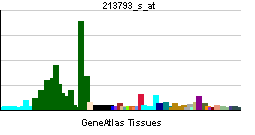HOMER1: Difference between revisions
Jump to navigation
Jump to search
m (Robot: Automated text replacement (-{{WikiDoc Cardiology Network Infobox}} +, -<references /> +{{reflist|2}}, -{{reflist}} +{{reflist|2}})) |
(No difference)
|
Revision as of 18:04, 4 September 2012
| Homer homolog 1 (Drosophila) | |||||||||||||
|---|---|---|---|---|---|---|---|---|---|---|---|---|---|
 PDB rendering based on 1ddv. | |||||||||||||
| |||||||||||||
| Identifiers | |||||||||||||
| Symbols | HOMER1 ; HOMER1A; HOMER1B; HOMER1C; SYN47; Ves-1 | ||||||||||||
| External IDs | Template:OMIM5 Template:MGI HomoloGene: 3155 | ||||||||||||
| |||||||||||||
| RNA expression pattern | |||||||||||||
 | |||||||||||||
| More reference expression data | |||||||||||||
| Orthologs | |||||||||||||
| Template:GNF Ortholog box | |||||||||||||
| Species | Human | Mouse | |||||||||||
| Entrez | n/a | n/a | |||||||||||
| Ensembl | n/a | n/a | |||||||||||
| UniProt | n/a | n/a | |||||||||||
| RefSeq (mRNA) | n/a | n/a | |||||||||||
| RefSeq (protein) | n/a | n/a | |||||||||||
| Location (UCSC) | n/a | n/a | |||||||||||
| PubMed search | n/a | n/a | |||||||||||
Homer homolog 1 (Drosophila), also known as HOMER1, is a human gene.[1]
This gene encodes a member of the homer family of dendritic proteins. Members of this family regulate group 1 metabotrophic glutamate receptor function.[1]
References
Further reading
- Xiao B, Tu JC, Worley PF (2000). "Homer: a link between neural activity and glutamate receptor function". Curr. Opin. Neurobiol. 10 (3): 370–4. PMID 10851183.
- Maruyama K, Sugano S (1994). "Oligo-capping: a simple method to replace the cap structure of eukaryotic mRNAs with oligoribonucleotides". Gene. 138 (1–2): 171–4. PMID 8125298.
- Hillier LD, Lennon G, Becker M; et al. (1997). "Generation and analysis of 280,000 human expressed sequence tags". Genome Res. 6 (9): 807–28. PMID 8889549.
- Brakeman PR, Lanahan AA, O'Brien R; et al. (1997). "Homer: a protein that selectively binds metabotropic glutamate receptors". Nature. 386 (6622): 284–8. doi:10.1038/386284a0. PMID 9069287.
- Suzuki Y, Yoshitomo-Nakagawa K, Maruyama K; et al. (1997). "Construction and characterization of a full length-enriched and a 5'-end-enriched cDNA library". Gene. 200 (1–2): 149–56. PMID 9373149.
- Xiao B, Tu JC, Petralia RS; et al. (1998). "Homer regulates the association of group 1 metabotropic glutamate receptors with multivalent complexes of homer-related, synaptic proteins". Neuron. 21 (4): 707–16. PMID 9808458.
- Tu JC, Xiao B, Yuan JP; et al. (1998). "Homer binds a novel proline-rich motif and links group 1 metabotropic glutamate receptors with IP3 receptors". Neuron. 21 (4): 717–26. PMID 9808459.
- Tu JC, Xiao B, Naisbitt S; et al. (1999). "Coupling of mGluR/Homer and PSD-95 complexes by the Shank family of postsynaptic density proteins". Neuron. 23 (3): 583–92. PMID 10433269.
- Roche KW, Tu JC, Petralia RS; et al. (1999). "Homer 1b regulates the trafficking of group I metabotropic glutamate receptors". J. Biol. Chem. 274 (36): 25953–7. PMID 10464340.
- Minakami R, Kato A, Sugiyama H (2000). "Interaction of Vesl-1L/Homer 1c with syntaxin 13". Biochem. Biophys. Res. Commun. 272 (2): 466–71. doi:10.1006/bbrc.2000.2777. PMID 10833436.
- Ango F, Prézeau L, Muller T; et al. (2001). "Agonist-independent activation of metabotropic glutamate receptors by the intracellular protein Homer". Nature. 411 (6840): 962–5. doi:10.1038/35082096. PMID 11418862.
- Wistow G, Bernstein SL, Wyatt MK; et al. (2002). "Expressed sequence tag analysis of human RPE/choroid for the NEIBank Project: over 6000 non-redundant transcripts, novel genes and splice variants". Mol. Vis. 8: 205–20. PMID 12107410.
- Feng W, Tu J, Yang T; et al. (2003). "Homer regulates gain of ryanodine receptor type 1 channel complex". J. Biol. Chem. 277 (47): 44722–30. doi:10.1074/jbc.M207675200. PMID 12223488.
- Strausberg RL, Feingold EA, Grouse LH; et al. (2003). "Generation and initial analysis of more than 15,000 full-length human and mouse cDNA sequences". Proc. Natl. Acad. Sci. U.S.A. 99 (26): 16899–903. doi:10.1073/pnas.242603899. PMID 12477932.
- Hwang SY, Wei J, Westhoff JH; et al. (2004). "Differential functional interaction of two Vesl/Homer protein isoforms with ryanodine receptor type 1: a novel mechanism for control of intracellular calcium signaling". Cell Calcium. 34 (2): 177–84. PMID 12810060.
- Norton N, Williams HJ, Williams NM; et al. (2004). "Mutation screening of the Homer gene family and association analysis in schizophrenia". Am. J. Med. Genet. B Neuropsychiatr. Genet. 120 (1): 18–21. doi:10.1002/ajmg.b.20032. PMID 12815733.
- Westhoff JH, Hwang SY, Duncan RS; et al. (2004). "Vesl/Homer proteins regulate ryanodine receptor type 2 function and intracellular calcium signaling". Cell Calcium. 34 (3): 261–9. PMID 12887973.
- Yuan JP, Kiselyov K, Shin DM; et al. (2003). "Homer binds TRPC family channels and is required for gating of TRPC1 by IP3 receptors". Cell. 114 (6): 777–89. PMID 14505576.
- Rong R, Ahn JY, Huang H; et al. (2003). "PI3 kinase enhancer-Homer complex couples mGluRI to PI3 kinase, preventing neuronal apoptosis". Nat. Neurosci. 6 (11): 1153–61. doi:10.1038/nn1134. PMID 14528310.
| This protein-related article is a stub. You can help Wikipedia by expanding it. |